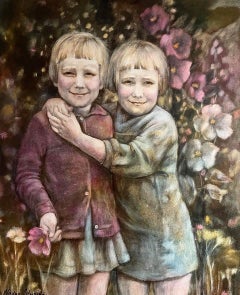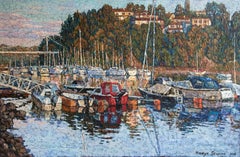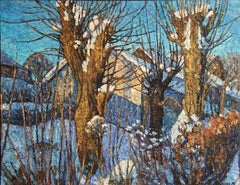Oslo - Art
to
8
58
31
58
148
40
Overall Width
to
Overall Height
to
335
102
78
48
29
12
3
2
1
1
159
111
44
53
32
28
27
23
22
20
19
18
16
15
14
12
11
10
9
7
7
6
6
323
230
230
221
168
2
32
231
233,731
151,134
Item Ships From: Oslo
Twins
Located in Oslo, NO
Very often, the artist draws his inspiration from childhood, because in childhood all the foundations of life and relationships are laid.The twins relationship is something special! ...
Category
2010s Other Art Style Oslo - Art
Materials
Canvas, Acrylic
View on Ulvøya, Painting, Oil on Canvas
Located in Yardley, PA
In this oil painting, I explore the interplay of light and reflection, capturing the serene ambiance of a marina bathed in the warm glow of sunset. The textured strokes convey a sens...
Category
2010s Impressionist Oslo - Art
Materials
Oil
«Are we growing apart?» Figurative Sculpture by Jim Darbu
By Jim Darbu
Located in Oslo, NO
With his sculptures, Jim Darbu invites you into a universe where bizarre stories unfold - a universe where colourful, strange creatures reign and shadows liv...
Category
2010s Pop Art Oslo - Art
Materials
Acrylic, Fiberboard, Resin
In the rays of the sun, Painting, Oil on Canvas
Located in Yardley, PA
As the creator of this piece, I poured my soul into capturing nature's transient beauty, embracing the dance between light and shadow. I chose oils for their rich texture, creating l...
Category
2010s Impressionist Oslo - Art
Materials
Oil
«Ta meg i mot» Figurative Oil Painting, toppless woman with blue boxing gloves
Located in Oslo, NO
«Ta meg i mot» oil on canvas by Anastína Eyjólfsdóttir.
A toppless woman equipped with blue boxing gloves poses by the shore. Behind her, the sky and small strip of sea create a bl...
Category
2010s Contemporary Oslo - Art
Materials
Canvas, Oil
«Completely Cracked» Figurative Sculpture by Norwegian artist Jim Darbu
By Jim Darbu
Located in Oslo, NO
"Signed and dated"
With his sculptures, Jim Darbu invites you into a universe where bizarre stories unfolds - a universe where colourful, strange creatures ...
Category
2010s Pop Art Oslo - Art
Materials
Porcelain, Stoneware
$2,400 Sale Price
20% Off
«Me and my girl» Acrylic on Canvas by O. F. Hvidsten
By Ole Fredrik Hvidsten
Located in Oslo, NO
Signed and dated.
«Me and my girl» was part of O. F. Hvidsten's first solo-exhibition «This will never pass». The works comprising the exhibition is first and foremost a visual mem...
Category
2010s Contemporary Oslo - Art
Materials
Canvas, Acrylic
«Meet the Queen» Still Life Oil Painting by Samantha Van Heest
By Samantha Van Heest
Located in Oslo, NO
Samantha Van Heest explores the intimacy of impermanence through her work, utilizing still life, found objects, and portraiture through minimalist r...
Category
2010s Contemporary Oslo - Art
Materials
Canvas, Oil
«Self portrait» Contemporary Abstract Oil Painting on Canvas, 2017 Expressionism
By Julia Kiryanova
Located in Oslo, NO
For Julia Kiryanova, painting is a dialogue – a dialogue which she beautifully facilitates, layering her work with various techniques.
At the heart of much of her work an inherent fascination for people lies, intimately displaying abandoned figures seemingly floating in an abstract dream world, where time has stopped everything, but them.
Julia Kiryanova has exhibited work at Amsterdam museum, Museum Op Solder and The Holocaust Museum...
Category
2010s Abstract Expressionist Oslo - Art
Materials
Canvas, Oil
Blue snow, Painting, Oil on CanvasBlue snow, Painting, Oil on Canvas
Located in Yardley, PA
In this oil on canvas, I captured a quiet village blanketed in snow, basking in the serene blue of winter's touch. The textured strokes and impressionistic style evoke the crisp air ...
Category
2010s Impressionist Oslo - Art
Materials
Oil
«Ave Maria» Large Figurative Oil Painting on Canvas by Giorgi Qochiashvili
By Giorgi Qochiashvili
Located in Oslo, NO
Giorgi Qochiashvili's colourful world is impressive to say the least. Inspired by poetry, Japanese culture and films of Jim Jarmush, he creates massive paintings...
Category
2010s Contemporary Oslo - Art
Materials
Canvas, Oil
«Young Peer» Contemporary Figurative Oil Painting on Canvas by Matteo Merla 2010
By Matteo Merla
Located in Oslo, NO
In our society where everything runs so fast, stopping to consume a painting forces us to stop and reflect on an idea or a problem and consequently helps us develop a capacity for se...
Category
2010s Contemporary Oslo - Art
Materials
Canvas, Oil
«This is not a prison» Acrylic on Canvas by Ole Fredrik Hvidsten
By Ole Fredrik Hvidsten
Located in Oslo, NO
Signed and dated.
«This is not a prison» was part of O. F. Hvidsten's first solo-exhibition «This will never pass». The works comprising the exhibition is first and foremost a visual memory of two dramatic years since 2020 that have affected us all. Covid, and its consequences, have become a common point of reference that we will all talk about and bear remembrance to for a long time. But our memories are like life itself; dynamic and in constant change, often weakening with time, and can either ebb out or be reinforced. O.F. Hvidstens work in this period stand out as an anchor point for this common experience.
Ole Fredrik Hvidsten...
Category
2010s Contemporary Oslo - Art
Materials
Canvas, Acrylic
«Can Not Be Pictured – OH NO OH NO! (The Sequoias)» large print by Tine Semb
Located in Oslo, NO
Large and unique print titled Can Not Be Pictured – OH NO OH NO! (The Sequoias).
Digital collage from digital photography [2011].
Diptych, toner print on 90 g pink paper, mounted o...
Category
2010s Modern Oslo - Art
Materials
Glass, Oak
«Boo-boos (by Lucio)» teal green cut canvas covered with cast plastic band-aids
By Dustin Cook
Located in Oslo, NO
Inspired by the intersection between human nature and human technology, Dustin Cook makes abstraction look funny. At the core, his work represents playfuln...
Category
2010s Contemporary Oslo - Art
Materials
Canvas, Plastic, Acrylic Polymer
$1,600 Sale Price
20% Off
«It was you that put your foot into my habitat» Ceramic Sculpture by Hvidsten
By Ole Fredrik Hvidsten
Located in Oslo, NO
Signed and dated.
«It was you that put your foot into my habitat» was part of O. F. Hvidsten's first solo-exhibition «This will never pass». The works com...
Category
2010s Contemporary Oslo - Art
Materials
Ceramic
«Waited for someone» Ceramic Sculpture by O. F. Hvidsten
By Ole Fredrik Hvidsten
Located in Oslo, NO
Signed and dated.
«Waited for someone, for something, for anything, for too long» was part of O. F. Hvidsten's first solo-exhibition «This will n...
Category
2010s Contemporary Oslo - Art
Materials
Ceramic, Clay
«So far, so good, and then...» Acrylic on Canvas by O. F. Hvidsten
By Ole Fredrik Hvidsten
Located in Oslo, NO
Signed and dated.
«So far, so good, and then...» was part of O. F. Hvidsten's first solo-exhibition «This will never pass». The works comprising the exhibition is first and foremos...
Category
2010s Contemporary Oslo - Art
Materials
Canvas, Acrylic
«Taking a chance on the dancefloor» Acrylic on Canvas by O. F. Hvidsten
By Ole Fredrik Hvidsten
Located in Oslo, NO
Signed and dated.
«Taking a chance on the dancefloor» was part of O. F. Hvidsten's first solo-exhibition «This will never pass». The works comprisi...
Category
2010s Contemporary Oslo - Art
Materials
Canvas, Acrylic
«Late night apiphany» Acrylic on Canvas by O. F. Hvidsten
By Ole Fredrik Hvidsten
Located in Oslo, NO
Signed and dated.
«Late night apiphany» was part of O. F. Hvidsten's first solo-exhibition «This will never pass». The works comprising the exhibition is first and foremost a visua...
Category
2010s Contemporary Oslo - Art
Materials
Canvas, Acrylic
«Doppler Modus» Acrylic on Canvas by O. F. Hvidsten
By Ole Fredrik Hvidsten
Located in Oslo, NO
Signed and dated.
«Doppler Modus» was part of O. F. Hvidsten's first solo-exhibition «This will never pass». The works comprising the exhibition is first and foremost a visual memo...
Category
2010s Contemporary Oslo - Art
Materials
Canvas, Acrylic
«This mask will last a lifetime» Acrylic on Canvas by O. F. Hvidsten
By Ole Fredrik Hvidsten
Located in Oslo, NO
Signed and dated.
«This mask will last a lifetime» was part of O. F. Hvidsten's first solo-exhibition «This will never pass». The works comprising the exhibition is first and forem...
Category
2010s Contemporary Oslo - Art
Materials
Canvas, Acrylic
«Good sharks makes all the difference» Acrylic on Canvas by O. F. Hvidsten
By Ole Fredrik Hvidsten
Located in Oslo, NO
Signed and dated.
«Good sharks makes all the difference» was part of O. F. Hvidsten's first solo-exhibition «This will never pass». The works comprising the exhibition is first and...
Category
2010s Contemporary Oslo - Art
Materials
Canvas, Acrylic
«O Donald, where aren't thou?» Acrylic on Canvas by O. F. Hvidsten
By Ole Fredrik Hvidsten
Located in Oslo, NO
Signed and dated.
«O Donald, where aren't thou?» was part of O. F. Hvidsten's first solo-exhibition «This will never pass». The works comprising the exhibition is first and foremost a visual memory of two dramatic years since 2020 that have affected us all. Covid, and its consequences, have become a common point of reference that we will all talk about and bear remembrance to for a long time. But our memories are like life itself; dynamic and in constant change, often weakening with time, and can either ebb out or be reinforced. O.F. Hvidstens work in this period stand out as an anchor point for this common experience.
Ole Fredrik Hvidsten...
Category
2010s Contemporary Oslo - Art
Materials
Canvas, Acrylic
«Packing right» Acrylic on Canvas by Ole Fredrik Hvidsten
By Ole Fredrik Hvidsten
Located in Oslo, NO
Signed and dated.
«Packing right» was part of O. F. Hvidsten's first solo-exhibition «This will never pass». The works comprising the exhibition is first and foremost a visual memo...
Category
2010s Contemporary Oslo - Art
Materials
Canvas, Acrylic
«Meg og deg» Acrylic on Canvas by O. F. Hvidsten
By Ole Fredrik Hvidsten
Located in Oslo, NO
Signed and dated.
«Meg og deg» was part of O. F. Hvidsten's first solo-exhibition «This will never pass». The works comprising the exhibition is first and foremost a visual memory ...
Category
2010s Contemporary Oslo - Art
Materials
Canvas, Acrylic
«We aim high to keep them down» Acrylic on Canvas by Ole Fredrik Hvidsten
By Ole Fredrik Hvidsten
Located in Oslo, NO
Signed and dated.
«We aim high to keep them down» was part of O. F. Hvidsten's first solo-exhibition «This will never pass». The works comprising the exhibi...
Category
2010s Pop Art Oslo - Art
Materials
Canvas, Acrylic
«Platina and Cheez Doodles» Ceramic Wall Relief by Nils Erichsen Martin
By Nils Erichsen Martin
Located in Oslo, NO
Signed and dated.
Nils Erichsen Martin's ceramics has a distinct style. He takes on a scientific approach with his artwork, researching into the different aspects of how form is per...
Category
2010s Contemporary Oslo - Art
Materials
Ceramic, Clay
«Black swan» Oil Painting of a solitary black circle on a layered background
Located in Oslo, NO
«Black swan» oil on canvas by Michael Andrew Phillips. A solitary black circle inhabits a white space layered on top of a dark yellow backgroun...
Category
2010s Contemporary Oslo - Art
Materials
Canvas, Oil
«Two birds» oil painting of two dancing birds in a mating ritual
By Benjamin Risk
Located in Oslo, NO
Drawing on a wealth of resources, Benjamin Risk invites you to join an adventure of unconscious thought and imagination where everything seems familiar, yet surreal.
With hi...
Category
2010s Contemporary Oslo - Art
Materials
Canvas, Wood, Oil
$1,000 Sale Price
20% Off
«Alyssum» Contemporary Abstract Oil Painting on Canvas, Norway, 2015
Located in Oslo, NO
«Golden» oil on canvas by Signe Solberg.
On a square-shaped canvas, a series of golden, straight lines rush across a white canvas. Although quite simplistic, the golden lines comes...
Category
2010s Contemporary Oslo - Art
Materials
Canvas, Oil
$1,200 Sale Price
20% Off
«A happy little accident» wall relief comprised of coloured, odd rounded shapes
By Dustin Cook
Located in Oslo, NO
Inspired by the intersection between human nature and human technology, Dustin Cook makes abstraction look funny. At the core, his work represents playfuln...
Category
2010s Contemporary Oslo - Art
Materials
Wood, Paint
$2,000 Sale Price
20% Off
«Red on black» wall relief of a red and black square on top of each other
By Hanne Øverland
Located in Oslo, NO
«Red on black» wall relief by Hanne Øverland.
intriguing and highly decorative wall relief. A red rectangle balances on the edge of a standing, black rectangle.
Category
2010s Contemporary Oslo - Art
Materials
Fiberglass, Wood
$1,360 Sale Price
20% Off
«Can Not Be Pictured – OH NO OH NO! (The Sequoias)» large Print by Tine Semb
Located in Oslo, NO
Unique and large print titled CAN NOT BE PICTURED – OH NO OH NO! (The Sequoias)
Digital collage from digital photography [2011].
Diptych, toner print on 90 g pink paper, mounted on...
Category
2010s Modern Oslo - Art
Materials
Glass, Oak
«Grid-Lock» Print by Tine Semb
Located in Oslo, NO
Digital print from drawing [2010] on 120 g paper, mounted on KAPAfix.
Glass and solid ash frames.
Approx. 60 x 90 cm / 23,62 x 35,43".
Unique, 2012.
Exhibited at Beers.Lambert Co...
Category
2010s Modern Oslo - Art
Materials
Glass, Paper
$2,857 Sale Price
20% Off
Recently Viewed
View AllMore Ways To Browse
John F Herring
John Van Hamersveld
Jose Vives Atsara Paintings
Jose Vives Atsara
Julyan Davis
L Ryder
Larry Fanning
Luis R Cuevas
Maine Lobster
Marc Chagall The Blue Sky Signed
Martin Cottage Painting
Mayhew Painting
Mens Vintage Military Jacket
Metropolis Vintage Poster
Morrow Oil
Mr Doodle
Noyes George
Oil Pump Vintage





